
South West USA trip, March 2016

Shaw based F-16C 00-0225 on finals at Nellis whilst a pair of Italian Air Force F-2000As join
The well worn path of touring around the South West of the USA was once again undertaken by a group of us during March. As is well known to most the members, this sort of tour is an essential regular event, but for those who have yet to venture that way, we shall try and provide some useful tips and basic pointers from which you can plan your own trip around.
Of course, initially, you'll want to make sure you have a group of like-minded individuals that you can get on with for an extended number of days. Then you need to chose some dates. Bear in mind that blistering summer days in the Arizona desert are liable to have an impact on visibility as well as health, something to be seriously considered. Generally speaking, February/March, or October/November are the optimum weather seasons, but these may not necessarily co-incide with exercise, airshow and other event dates.
 Our initial planning was based upon the provisional airshow dates (check the websites of The Thunderbirds, the Blue Angels, plus Scramble for the earliest heads-up on these dates), so we got our flights booked early to take these into account. Shortly after this of course, there were some changes to The Thunderbirds schedule and a consequent change of airshows! Our itinerary managed to take in the end of a Red Flag exercise at Nellis, plus the beginnings of an FWIT course at Yuma. So, with the basic fixed events sorted, it gave us an opportunity to fill in the gaps, to ensure we had a complete schedule, with no wasted time.
Our initial planning was based upon the provisional airshow dates (check the websites of The Thunderbirds, the Blue Angels, plus Scramble for the earliest heads-up on these dates), so we got our flights booked early to take these into account. Shortly after this of course, there were some changes to The Thunderbirds schedule and a consequent change of airshows! Our itinerary managed to take in the end of a Red Flag exercise at Nellis, plus the beginnings of an FWIT course at Yuma. So, with the basic fixed events sorted, it gave us an opportunity to fill in the gaps, to ensure we had a complete schedule, with no wasted time.
Soon enough, the time to travel arrives, and a non-stop flight with British Airways from Heathrow to Los Angeles marks the beginning of the trip. At LAX a short courtesy bus ride to the car rental agency to collect the vehicle (make sure you specify unlimted mileage, and have no State restrictions), then head out of Los Angeles towards the first night stop in Las Vegas. This is a few hours drive from LA, and taking into account the 8 or 9 hours time difference from the UK, means for a pretty long first day, especially if you want to take in some of the sights of "the strip".
 A very early start is recommended at Nellis, in order to read off and photograph as much of the flightline aircraft from the housing estate before the heat haze gets too bad, and don't
underestimate exactly how early the haze can become a problem. Scramble's viewing guide gives a good idea of where to view from at Nellis, and after your initial sightings you should have time to get some breakfast and stock up on drinks and food for the day before postioning yourselves for the days missions. Be aware that you will NOT always be in the perfect position to photograph every departing or arriving aircraft though. Nellis has two parallel runways, and both are used at the same time, for both arrivals and departures. Also, unless there are
greater than 10 - 15 knot winds, take-offs and landings can be from either end, often just to allow the aircraft to have a shorter taxy to and from their parking ramps. Unless the winds are extremely adverse, larger and live-armed aircraft will generally depart AWAY from Las Vegas. The Speedway track location is generally best for landing shots, and there are usually plenty of people around viewing the returning aircraft, so parking up here is not a problem. However, keep alert here as aircraft could still be departing off one runway whilst arrivals are
occurring, using the adjacent runways, but even in opposite directions at the same time.
A very early start is recommended at Nellis, in order to read off and photograph as much of the flightline aircraft from the housing estate before the heat haze gets too bad, and don't
underestimate exactly how early the haze can become a problem. Scramble's viewing guide gives a good idea of where to view from at Nellis, and after your initial sightings you should have time to get some breakfast and stock up on drinks and food for the day before postioning yourselves for the days missions. Be aware that you will NOT always be in the perfect position to photograph every departing or arriving aircraft though. Nellis has two parallel runways, and both are used at the same time, for both arrivals and departures. Also, unless there are
greater than 10 - 15 knot winds, take-offs and landings can be from either end, often just to allow the aircraft to have a shorter taxy to and from their parking ramps. Unless the winds are extremely adverse, larger and live-armed aircraft will generally depart AWAY from Las Vegas. The Speedway track location is generally best for landing shots, and there are usually plenty of people around viewing the returning aircraft, so parking up here is not a problem. However, keep alert here as aircraft could still be departing off one runway whilst arrivals are
occurring, using the adjacent runways, but even in opposite directions at the same time.
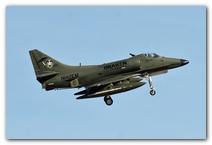 |
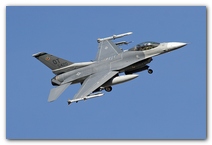 |
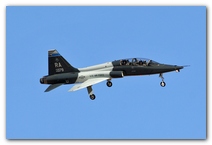 |
| Former RNZAF A-4 Skyhawk | Nellis based F-16C | T-38 from Randolph |
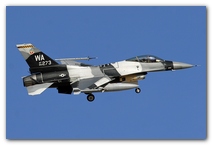 |
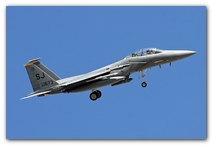 |
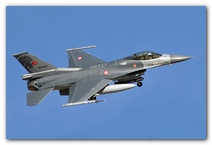 |
| Aggressor F-16C | Seymour Johnson Strike Eagle | Turkish Air Force F-16C |
 So, with plenty of photos and numbers, it is time to head south, with just enough light remaining to see the collection of stored T-28s at Nelson, a hotel at Yuma was beckoning. Don't underestimate the immense journey distances, and don't take chances on filling your rental vehicle up with fuel, because gas stations in the desert are sometimes few and far between. Also, take note that Arizona is in Mountain time zone (rather than the Pacific time zone of Nevada and California), but MOST of the state does NOT observe daylight savings time. If you are travelling in the region in March or October, the change to/from Daylight Savings Time may cause confusion.
So, with plenty of photos and numbers, it is time to head south, with just enough light remaining to see the collection of stored T-28s at Nelson, a hotel at Yuma was beckoning. Don't underestimate the immense journey distances, and don't take chances on filling your rental vehicle up with fuel, because gas stations in the desert are sometimes few and far between. Also, take note that Arizona is in Mountain time zone (rather than the Pacific time zone of Nevada and California), but MOST of the state does NOT observe daylight savings time. If you are travelling in the region in March or October, the change to/from Daylight Savings Time may cause confusion.
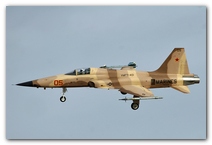 |
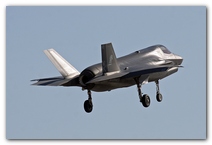 |
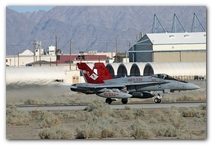 |
| Yuma based F-5 turning on finals | Based F-35B landing at Yuma | Visiting F/A-18 departing Yuma |
 Next morning and heading to nearby MCAS Yuma, and the Marines are quite happy to start flying early in the day, with mission
launches from 07:30 not uncommon. Generally they will fly the same few aircraft repeatedly throughout the day, so you are liable to see each unit flying the same 4 to 6 aircraft three or four times a day. The Yuma flightlines are covered in sunshades, making reading off the aircraft in them problematic, however good shots of landing aircraft can be had from both runway ends. Nearby Laguna AAF was also visited for some of its special aircraft.
Next morning and heading to nearby MCAS Yuma, and the Marines are quite happy to start flying early in the day, with mission
launches from 07:30 not uncommon. Generally they will fly the same few aircraft repeatedly throughout the day, so you are liable to see each unit flying the same 4 to 6 aircraft three or four times a day. The Yuma flightlines are covered in sunshades, making reading off the aircraft in them problematic, however good shots of landing aircraft can be had from both runway ends. Nearby Laguna AAF was also visited for some of its special aircraft.
After another night in the same hotel, the next morning saw a reasonable start as we headed off to El Centro in California for the airshow. American airshows are generally awkward for static photography as crowd barriers are not usually employed, and the general public are allowed to get next to the aircraft. The airshows are worthwhile attending though, as there are usually some gems to see, often warbirds, and you can always get a decent wet burger. Also, this is a chance to chat to some of the crews, and get some good information from them or arrange a unit visit with them.
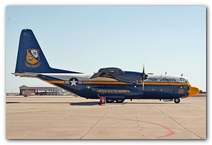 |
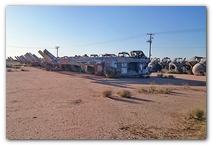 |
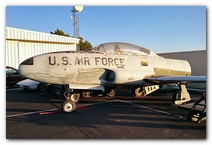 |
| Blue Angels Hercules at El Centro | Casa Grande stored H-19s | T-33 at Eloy, AZ |
Departing the airshow promptly (usually BEFORE the main display team finish their routine) allows us to head East towards Tucson, via some stops at Gila Bend (F-101s), Casa Grande (H-19s), Eloy and then a convenient fuel stop next to an AH-1 near Marana, we get to our next hotel, near Tucson International Airport.
 Sunday morning gets us up and out with a quick spin around the airport to catch the visiting military aircraft (C-130, UH-72, Eglin A-10,
UH-60s) as well as the ANG and Iraqi F-16s under the sunshades, before heading across to Davis Monthan for the airshow. Again, an early start at the show is recommended, as the static areas will be slightly less crowded with people. A huge haul of A-10s and plenty of other based aircraft, as well as a good supply of visiting air force aircraft made this quite a decent airshow, and as is expected in Arizona, the sun shone brightly all day. More beers and burgers and then departing in decent time across to Pima Museum to see what had changed since our last visit.
Sunday morning gets us up and out with a quick spin around the airport to catch the visiting military aircraft (C-130, UH-72, Eglin A-10,
UH-60s) as well as the ANG and Iraqi F-16s under the sunshades, before heading across to Davis Monthan for the airshow. Again, an early start at the show is recommended, as the static areas will be slightly less crowded with people. A huge haul of A-10s and plenty of other based aircraft, as well as a good supply of visiting air force aircraft made this quite a decent airshow, and as is expected in Arizona, the sun shone brightly all day. More beers and burgers and then departing in decent time across to Pima Museum to see what had changed since our last visit.
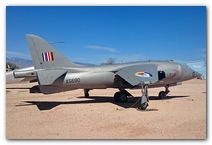 |
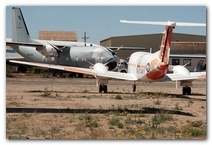 |
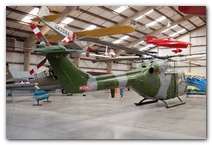 |
| Kestrel at Pima Museum | Pima Museum storage area | Ex AAC Lynx inside at Pima |
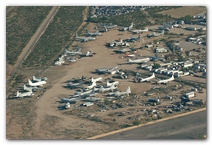 |
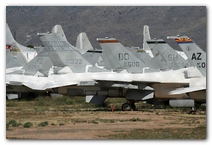 |
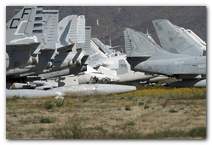 |
| Arial view of a scrapyard | AMARG from the fenceline | AMARG Area 21 |
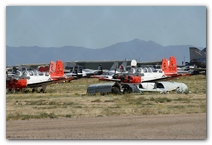 |
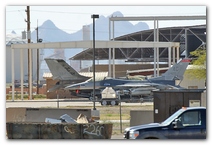 |
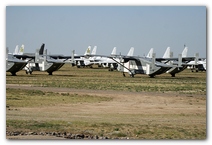 |
| AMARG Area 22 | AMARG Maintenance Area | Recently arrived C-23s |
Pima Museum holds a huge collection of aircraft, and it is worth taking a few hours here if you have not been before. Plan your visit to alternate between some outside areas and cool hangars, but pay close attention to the outside storage and restoration areas, as there are some tightly packed gems in this area. The nearby scrapyards are also worth a look too, despite being nowhere near as busy as they once were, there are still a good number of aircraft in them. The afternoon also allowed us to have a walk along the AMARG fenceline, one place to especially concentrate on is the area around then maintenance and arrival shelters and flightlines. Back to our Tucson hotel again for the Sunday night and ready for the next day.
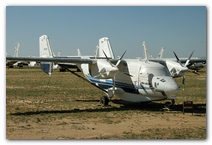 |
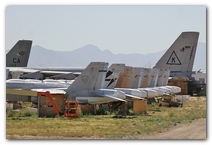 |
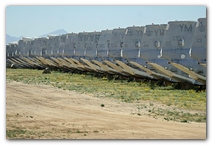 |
| M-28 in Celebrity Row | F-18s in front of B-52s | A lineup of H-46s |
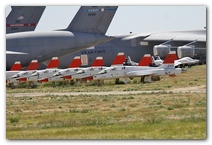 |
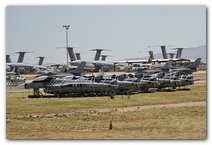 |
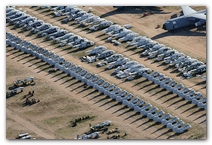 |
| Korean T-38s in front of C-5s | F-16s reportedly due to Indonesia | Lines of helicopters |
Monday morning sees us back at Pima Museum, booking TWO AMARG bus tours each, so you can get a seat on either side of the bus as it progresses through AMARG. Take plenty of reference pictures through the tinted windows, again pay special attention to the maintenance areas, and keep looking BEHIND you too, as there are often aircraft tucked away behing buildings and crates.
 In the afternoon we moved back across to Tucson Airport, to take some photos of the operating F-16s before reporting to Double Eagle Aviation to take our AMARG overflights. These should be booked in advance to make sure they can fit in with your schedule, but try and have some flexibility, because they are subject to the whim of Davis Monthan's operational needs. The guys at Double Eagle are completely aware of enthusiasts' needs and go out of their way to obtain the best photo opportunities (even during the taxy out!) within the constraints of Davis Monthan's operations. Your flight may be subject to early termination if a flight of A-10s are returning, or a C-130 is circuit bashing for a while, but these sort of events are outside Double Eagle's control. Flights early in the morning or late in the afternoon are
preferable, for visibility, turbulence, and shadow reasons, and Double Eagle are often prepared to fly as early as 7am, so it is worth asking.
In the afternoon we moved back across to Tucson Airport, to take some photos of the operating F-16s before reporting to Double Eagle Aviation to take our AMARG overflights. These should be booked in advance to make sure they can fit in with your schedule, but try and have some flexibility, because they are subject to the whim of Davis Monthan's operational needs. The guys at Double Eagle are completely aware of enthusiasts' needs and go out of their way to obtain the best photo opportunities (even during the taxy out!) within the constraints of Davis Monthan's operations. Your flight may be subject to early termination if a flight of A-10s are returning, or a C-130 is circuit bashing for a while, but these sort of events are outside Double Eagle's control. Flights early in the morning or late in the afternoon are
preferable, for visibility, turbulence, and shadow reasons, and Double Eagle are often prepared to fly as early as 7am, so it is worth asking.
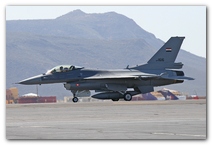 |
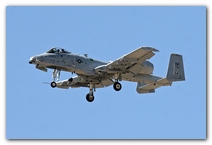 |
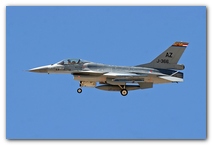 |
| Iraqi F-16 taxies out at Tucson | DP A-10 overshooting Tucson | Dutch F-16 returning to Tucson |
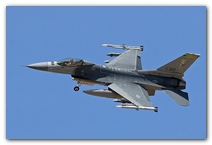 |
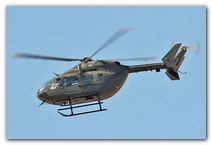 |
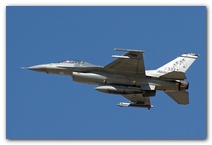 |
| Vermont F-16 on finals | Lakota overshooting Tucson | Warhawks F-16 departing Tucson |
 After a final night in Tucson, Tuesday morning sees another scrapyard visit for some of us, and a morning at the end of Tucson's runway for others.
After a final night in Tucson, Tuesday morning sees another scrapyard visit for some of us, and a morning at the end of Tucson's runway for others.
 The blazing Arizona sunlight means that mornings and late afternoons are best for pictures, the middle of the day has really harsh sunlight. So, lunchtime sees us set off for a pre-arranged visit to the former Avra Valley, to have a look around the aircraft at ATW. The airfield hosts a couple of companies who deal with old fighters and transports, and we were shown around some of the facilites here with no problem. The afternoon sees us head north (via Marana and Silver Bell) towards Phoenix. A quick look around the Boeing facility at Mesa bagged us a handful of brand new Korean
AH-64E Apaches, before we headed across to Luke AFB, just ahead of the rush hour traffic. We managed half an hour or so at Luke before the sun set (note that the sun goes down pretty rapidly in this part of the world), and caught a few F-35 evening missions departing, including an Australian example.
The blazing Arizona sunlight means that mornings and late afternoons are best for pictures, the middle of the day has really harsh sunlight. So, lunchtime sees us set off for a pre-arranged visit to the former Avra Valley, to have a look around the aircraft at ATW. The airfield hosts a couple of companies who deal with old fighters and transports, and we were shown around some of the facilites here with no problem. The afternoon sees us head north (via Marana and Silver Bell) towards Phoenix. A quick look around the Boeing facility at Mesa bagged us a handful of brand new Korean
AH-64E Apaches, before we headed across to Luke AFB, just ahead of the rush hour traffic. We managed half an hour or so at Luke before the sun set (note that the sun goes down pretty rapidly in this part of the world), and caught a few F-35 evening missions departing, including an Australian example.
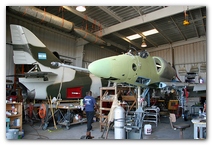 |
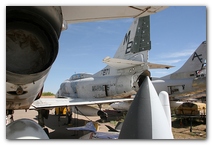 |
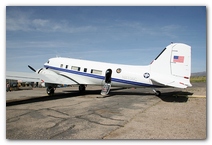 |
| A-4 being restored at Avra Valley | Stored A-4s at Avra Valley | Douglas C-53 at Avra Valley |
Wednesday was planned as a full day at Luke, and this turned out to be a very successful day, with plenty of F-35 and F-16 missions taking place. There was also a TDY deployment of Texas ANG F-16s operating from here using the nearby Barry Goldwater ranges, and this unit flew a couple of waves during the day. In contrast with the USMC at Yuma, the USAF F-35 units at Luke seemed happy to fly different aircraft throughout the day, and we only noted a couple of aircraft flying more than one sortie during the day. This meant that plenty of the fleet flew, and helped us towards achieving our self-imposed challenge of seeing 35 different F-35s on our trip. A decent enough start at Nellis was followed by a slightly disappointing haul at Yuma (as they utilised the same frames repeatedly), but a good selection at Luke upped our numbers into the 30's. At this point, we found out that the imminent FWIT course at Yuma should be expecting the aircraft arrivals over the next couple of days, so our flexibility meant we were in a good position to re-plan our trip to take in another visit to Yuma.
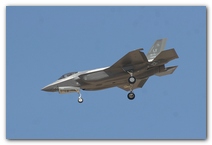 |
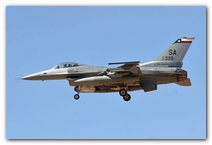 |
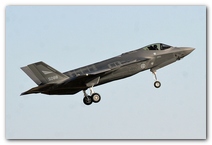 |
| 62 FS F-35A landing at Luke | Texan ANG F-16C | Norwegian F-35A |
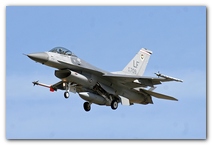 |
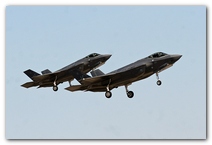 |
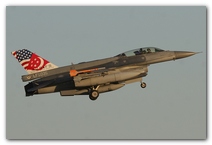 |
| Taiwanese F-16A | A pair of USAF F-35As | Singapore F-16D |
Thursday morning sees us head South West from Phoenix, getting to Yuma before lunchtime, to be greeted with a pan gradually filling with MV-22s, CH-53s, AH-1s, UH-1s, F-18s, AV-8Bs and KC-130Js. Feeling pretty pleased with our decision we carried on photographing the arrivals throughout the afternoon, plus the bonus of a couple of flights of AH-64s fuel stopping from North Carolina.
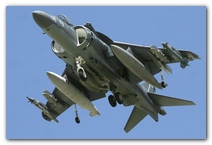 |
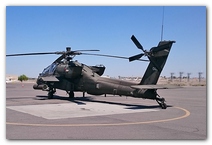 |
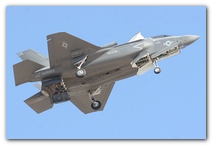 |
| AV-8B hover landing at Yuma | Fuel stopping AH-64 from Raleigh | F-35B hover landing |
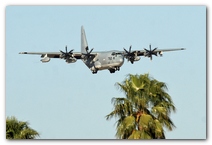 |
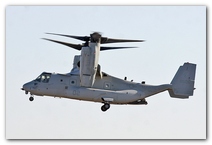 |
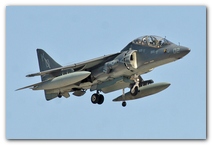 |
| KC-130J arriving at Yuma | MV-22 arriving for FWIT | Two-seater TAV-8B |
Another night in Yuma allowed us to spend more time on Friday to see further FWIT arrivals, and by the time we headed off we had seen 36 different F-35s in total, as well as plenty more F-18s, MV-22s and other helicopters. A quick stop at El Centro as we passed en-route to Miramar and our hotel for the Friday night.
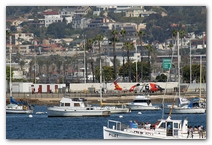 |
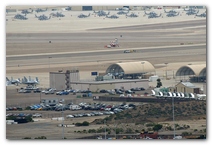 |
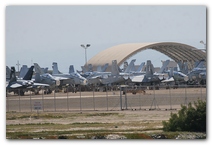 |
| USCG station San Diego | View over North Island | F-18s from the North Harbor tour |
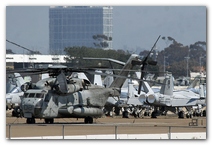 |
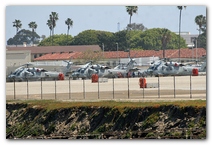 |
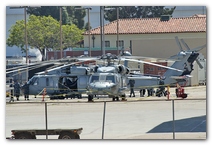 |
| North Harbor tour views | H-60s left out on the flightline | Seahawks under maintenance |
Saturday morning meant the beautiful city of San Diego, and look at NAS North Island. The height of Point Lomo gives a good but distant overview of the airfield, but from the starboard upper deck of the North Harbor tours a decent chance to see the aircraft can be obtained as the vessel sails slowly past the base. Again, take plenty of photographs from various angles on this tour. Also in San Diego harbor, the Coast Guard station has some MH-60 Jayhawks, and the USS Midway Museum houses a good collection of aircraft, both above deck and in the below deck hangars. The afternoon saw us drive north from San Diego to the rotorcraft museum at Ramona, don't forget to check out the airfield hangars here for some exotic types. Heading further north to Hemet Ryan then finally getting to March ARB, just in time to get an escorted tour around the Museum. There is a QRA detachment of F-16s located here, as well as the based C-17s and KC-135s.
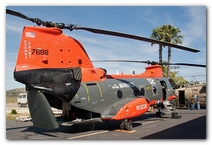 |
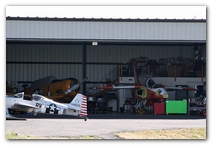 |
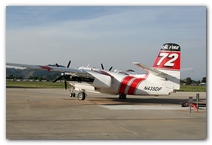 |
| H-46 at Ramona | T-6 and S.211 at Ramona | S-2 at Hemet |
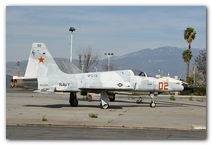 |
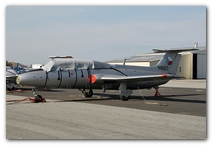 |
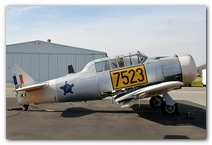 |
| F-5 at Hemet | L-29 at Hemet | Harvard at Hemet |
Saturday night in Los Angeles (make sure you book your hotel accommodation well in advance!) then left us Sunday morning for a visit to Chino, for the airfield and the two excellent museums, before heading back to LAX via the California Science Center.
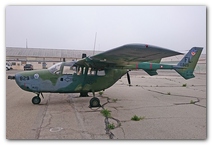 |
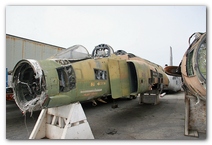 |
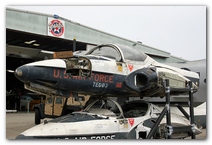 |
| O-2 at Chino Airfield | 64-0915 at Yanks Air Museum | T-37s at Yanks Air Museum |
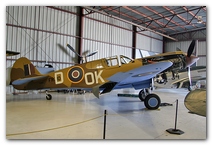 |
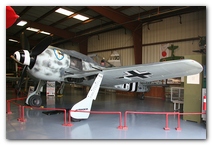 |
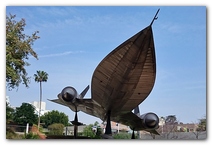 |
| NX40DF at Planes of Fame | White 14 at Planes of Fame | A-12 in Los Angeles |
So, that is a brief overview of our intinerary. We had pre-planned most of it beforehand, but left ourselves some flexibility towards the tail end, which we found useful. The security forces are much more understanding these days, and we didn't experience ANY issues at all outside the bases.
Thanks must be given to the numerous group members who supplied information and tips enabling us to make the most of our trip. If you have not tried this sort of trip, you should have no qualms about trying it. We took around 7,500 photographs, and saw over 6,000 military aircraft in 12 days,
travelling over 2,200 miles, and nowhere on earth will allow you to see that amount and diversity under such clear and cloudless conditions.